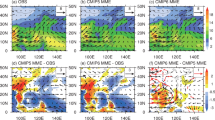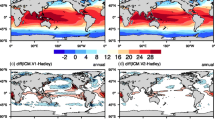Abstract
The delayed impacts of the central Pacific (CP) El Niño on the East Asian summer monsoon (EASM) are evaluated by comparing historical runs from Coupled Model Intercomparison Project Phase 5 models against reanalysis data. In observations, an anomalous western North Pacific anticyclone (WNPAC), linking CP El Niño to the EASM, forms due to the transition of sea surface temperature (SST) warming into SST cooling over the CP, which generates a WNPAC through a Gill–Matsuno response. In comparison with the observational result, only one-third of the models (i.e., the type-I models) capture a weaker and smaller WNPAC, whereas the other two-thirds (i.e., the type-II models) fail to reproduce a WNPAC. The simulation biases in both of type-I models and type-II models mainly arise from an unrealistic, long-lasting CP El Niño warming, which causes a north Indian Ocean SST warming bias in models through air–sea interaction process. This north Indian Ocean SST warming generates the WNPAC through capacitor effects, which is different from the WNPAC formation mechanism in observations. This discrepancy leads to simulation biases in type-I models. In type-II models, the unrealistic CP El Niño warming persists into summer, which produces an anomalous cyclone over the central-western Pacific. The opposite effect of the CP and north Indian Ocean SST warming on the WNP atmospheric circulation leads to disappearance of the WNPAC. Hence, large simulation biases are produced in type-II models. Further analysis demonstrates the slow decay of CP El Niño is caused by the unrealistically simulated climatological SST, which creates strong warm meridional oceanic advection and results in a sustained CP El Niño warming.













Similar content being viewed by others
References
Ashok K, Behera KS, Rao SA, Weng HY, Yamagata T (2007) El Niño Modoki and its possible teleconnection. J Geophys Res 112:C11007. https://doi.org/10.1029/2006JC003798
Bao M, Han RQ (2009) Delayed impacts of the El Nino episodes in the central Pacific on the summertime climate anomalies of eastern China in 2003 and 2007. Adv Atmos Sci 3:553–563
Bao Q, Lin PF, Zhou TJ, Liu YM, Yu YQ, Wu GX, He B, He J, Li LJ, Li JD, Li YC, Liu HL et al (2013) The flexible global ocean-atmosphere-land system model, spectral version 2: FGOALS-s2. Adv Atmos Sci 30:561–576
Carton JA, Giese BS (2008) A reanalysis of ocean climate using Simple Ocean Data Assimilation (SODA). Mon Weather Rev 136:2999–3017
Chang C, Zhang Y, Li T (2000) Interannual and interdecadal variations of the East Asian summer monsoon and tropical Pacific SSTs Part I: roles of the subtropical ridge. J Clim 13:4310–4325
Chou C, Huang L-F, Tu JY, Tseng L, Hsueh Y-C (2009) El Niño impacts on precipitation in the Western North Pacific-East Asian sector. J Clim 22:2039–2057
Du Y, Xie SP, Huang G, Hu KM (2009) Role of air–sea interaction in the long persistence of El Niño-induced north Indian Ocean warming. J Clim 22:2023–2038
Feng J, Chen W, Tam CY, Zhou W (2011) Different impacts of El Niño and El Niño Modoki on China rainfall in the decaying phases. Int J Climatol 31:2091–2101
Feng J, Liu P, Chen W, Wang XC (2015) Contrasting Madden–Julian Oscillation activity during various stages of EP and CP El Niños. Atmos Sci Lett 16:32–37
Gill AE (1980) Some simple solutions for heat-induced tropical circulation. Q J R Meteorol Soc 106:447–462
Ham Y-G, Kug J-S (2012) How well do current climate models simulate two types of El Nino? Clim Dyn 39:383–398
Huang RH, Wu YF (1989) The influence of ENSO on the summer climate change in China and its mechanism. Adv Atmos Sci 6:21–32
Huang R, Chen J, Wang L, Lin Z (2012) Characteristics, processes, and causes of the spatio-temporal variabilities of the East Asian monsoon system. Adv Atmos Sci 29:910–942
Jiang WP, Huang G, Hu KM, Wu RG, Gong HN, Chen XL, Tao WC (2017) Diverse relationship between ENSO and the Northwest Pacific summer climate among CMIP5 models: dependence on the ENSO decay pace. J Clim 30:109–127
Kalnay E et al (1996) The NCEP/NCAR 40-year reanalysis project. Bull Am Meteorol Soc 77:437–471
Kao HY, Yu JY (2009) Contrasting eastern-Pacific and central-Pacific types of ENSO. J Clim 22:615–632
Kug JS, Jin FF, An SI (2009) Two types of El Niño events: cold tongue El Niño and warm pool El Niño. J Clim 22:1499–1515
Larkin NK, Harrison DE (2005) Global seasonal temperature and precipitation anomalies during El Niño autumn and winter. Geophys Res Lett 32:L16705
Li T, Tung C, Hwu JW (2005) Remote and local SST forcing in shaping Asian-Australian monsoon anomalies. J Meteorol Soc Jpn 83:153–167
Liu Y, Ding Y (1992) Influence of El Niño on weather and climate in China. Acta Meteorol Sin 6:117–131
Matsuno T (1966) Quasi-geostrophic motions in the equatorial area. J Meteorol Soc Jpn 44:25–43
Ninomiya K, Murakami T (1987) The early summer rainy season (Baiu) over Japan. Chang C-P, Krishnamurti TN (eds) Monsoon meteorology. Oxford University Press, Oxford, pp 93–121
Rayner N et al (2003) Global analyses of sea surface temperature, sea ice, and night marine air temperature since the late nineteenth century. J Geophys Res. https://doi.org/10.1029/2002JD002670
Rong XY, Zhang RH, Li T (2010) Impacts of Atlantic sea surface temperature anomalies on Indo-East Asian summer monsoon-ENSO relationship. Chin Sci Bull 55:2458–2468
Song FF, Zhou TJ (2014) The climatology and interannual variability of East Asian summer monsoon in CMIP5 coupled models: does air–sea coupling improve the simulations? J Clim 27:8761–8777
Taschetto AS, Gupta AS, Jourdain NC, Santoso A, Ummenhofer CC, England MH (2014) Cold tongue and warm pool ENSO events in CMIP5: mean state and future projections. J Clim 27:2861–2885
Vimont DJ, Battisti DS, Hirst AC (2001) Footprinting: a seasonal connection between the tropics and mid-latitudes. Geophys Res Lett 28:3923–3926
Wang B, Wu R, Fu X (2000) Pacific-east Asian teleconnection: how does ENSO affect east Asian climate? J Clim 13:1517–1536
Wang XC, Liu YM, Wu GX, Lin SJ, Bao Q (2013) The application of flux-form semi-lagrangian transport scheme in a spectral atmosphere model. Adv Atmos Sci 30:89–100
Weng HY, Ashok K, Behera SK, Rao SA, Yamagata T (2007) Impacts of recent El Niño Modoki on dry/wet conditions in the Pacific rim during boreal summer. Clim Dyn 29:113–129
Wu B, Zhou TJ (2016) Relationships between ENSO and the East Asian-western North Pacific monsoon: observations versus 18 CMIP5 models. Clim Dyn 46:729–743
Wu R, Hu ZZ, Kirtman BP (2003) Evolution of ENSO-related rainfall anomalies in East Asia. J Clim 16:3742–3758
Wu B, Zhou TJ, Li T (2009) Seasonally evolving dominant interannual variability modes of East Asian climate. J Clim 22:2992–3005
Wu B, Zhou TJ, Li T (2017a) Atmospheric dynamics and thermodynamic processes driving the western North Pacific anomalous anticyclone during El Nino. Part I: maintenance mechanisms. J Clim 30:9621–9635
Wu B, Zhou TJ, Li T (2017b) Atmospheric dynamics and thermodynamic processes driving the western North Pacific anomalous anticyclone during El Nino. Part II: formation processes. J Clim 30:9637–9650
Xie SP, Hu K, Hafner J, Tokinaga H, Du Y, Huang G, Sampe T (2009) Indian Ocean capacitor effect on Indo-western Pacific climate during the summer following El Niño. J Clim 22:730–747
Yang JL, Liu QY, Xie SP, Liu ZY, Wu LX (2007) Impact of the Indian Ocean SST basin mode on the Asian summer monsoon. Geophys Res Lett 34:L02708. https://doi.org/10.1029/2006GL028571
Yeh SW, Kug JS, Dewitte B, Kwon MH, Kirtman BP, Jin FF (2009) El Niño in a changing climate. Nature 461:511–514
Yuan Y, Yang S, Zhang Z (2012) Different evolutions of the Philippine Sea anticyclone between the eastern and central Pacific El Niño: possible effects of Indian Ocean SST. J Clim 25:7867–7883
Zhang R, Sumi A, Kimoto M (1996) Impact of El Niño on the East Asian monsoon: a diagnostic study of the’86/87 and’91/92 events. J Meteorol Soc Jpn 74:49–62
Acknowledgements
This study was supported jointly by the National Key Research and Development Program (Grant No. 2016YFA0600604) and the National Natural Science Foundation of China (Grant Nos. 41675091 and 41230527).
Author information
Authors and Affiliations
Corresponding author
Rights and permissions
About this article
Cite this article
Feng, J., Chen, W., Gong, H. et al. An investigation of CMIP5 model biases in simulating the impacts of central Pacific El Niño on the East Asian summer monsoon. Clim Dyn 52, 2631–2646 (2019). https://doi.org/10.1007/s00382-018-4284-2
Received:
Accepted:
Published:
Issue Date:
DOI: https://doi.org/10.1007/s00382-018-4284-2




